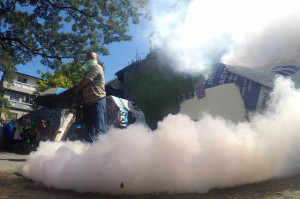GENEVA: The World Health Organization (WHO) on Monday said a surge in serious birth defects in South America was “strongly suspected” of being caused by the Zika virus and constituted an international health emergency.
The UN health body said the surge in cases of microcephaly--a devastating condition in which a baby is born with an abnormally small head and brain-- was likely caused by the mosquito-borne Zika virus and declared the situation a “public health emergency of international concern.”
WHO chief Margaret Chan said a meeting of health experts who make up the agency’s emergency committee had agreed “a causal relationship between the Zika infection during pregnancy and microcephaly is strongly suspected, though not scientifically proven.”
“The clusters of microcephaly and other neurological complications constitute an extraordinary event and a public health threat to other parts of the world,” she noted.
WHO warned last week that the mosquito-borne virus was “spreading explosively” in the Americas, and said the region could see up to four million Zika cases this year alone.
For decades after Zika was first discovered in Uganda in 1947, the mosquito-borne virus was of little concern, sporadically causing “mild” illness in human populations.
But although the symptoms of virus have until now appeared benign, growing indications of a link to microcephaly and a rare neurological disorder called Guillain-Barre syndrome have stirred growing alarm.
“Zika alone would not be a public health emergency of international concern,” explained David Heymann, who headed Monday’s WHO emergency committee meeting.
He said the urgent need to scientifically establish whether the clusters of microcephaly and Guillain Barre are caused by Zika, but acknowledged that “it will take time.”
In the meantime, Chan said, the world could not put off coordinating measures to protect against the spread of Zika, in the affected region and beyond.
Brazil was the first to sound the alarm in the current crisis, warning in October that a rash of microcephaly cases had emerged in the northeast.
It has since become the worst affected country, with some 4,000 suspected cases of microcephaly, of which 270 have been confirmed, up from 147 in 2014.
WHO on Monday said French Polynesia had also seen a spike in microcephaly cases during a Zika outbreak there two years ago.
As alarm grows over the surge in number of cases, Colombia, Ecuador, El Salvador, Jamaica and Puerto Rico have warned women to delay conceiving until the Zika outbreak is brought under control.
Colombia, which has reported more than 20,000 Zika infections, including 2,100 in pregnant women, meanwhile warned also on Monday that it was expecting an “explosion” of cases of Guillain-Barre syndrome, a serious condition affecting the nervous system.
Panama had also registered 50 Zika cases, and jitters over the virus have spread far beyond the affected areas to Europe and North America, where dozens of cases have been identified among people returning from holiday or business trips.
WHO is looking to take resolute action on Zika after coming in for stinging criticism over its initially sluggish response to the devastating West Africa Ebola outbreak.
WHO also on Monday stressed the need to improve diagnostics and develop a vaccine for Zika -- for which there is currently no treatment.
It refrained from issuing travel warnings, although Chan hinted that pregnant women might want to avoid travel to Zika-affected areas, if possible.
Testing centers
Amid the WHO warning, the Philippines opened six Zika testing centers.
Health Secretary Janette Garin said the testing centers include the Research Institute for Tropical Medicine in Muntinlupa City (Metro Manila), Baguio General Hospital in Baguio City, Vicente Sotto Memorial Medical Center in Cebu City, Southern Philippines Medical Center in Davao City, Lung Center of the Philippines in Quezon City and San Lazaro Hospital in Manila.
The country has at least 1,000 Zika virus testing kits and a thousand more will arrive by next week, Garin announced.
Testing kits for the Zika virus will also be commercially available in the country soon.
Garin said only persons with Zika symptoms will be tested.
The Philippine Red Cross (PRC), meanwhile, urged the public to clean their surroundings regularly and remove all breeding grounds of mosquitoes.
“Similar to our dengue prevention campaign, the Philippine Red Cross is mobilizing all staff and 143 volunteers all over the country to lead and encourage all communities to practice cleanliness and remove all possible areas where mosquitoes breed,” PRC Chairman Richard Gordon said.
“To maintain the safety of our blood supply, I have also instructed all PRC blood service facilities to ask blood donors if they have traveled to Zika virus-affected countries prior to blood donation. For potential donors who have traveled to Zika-infected areas, we advise that you defer your blood donation a month following your return to lessen the risk of passing the virus to others,” Gordon added.


